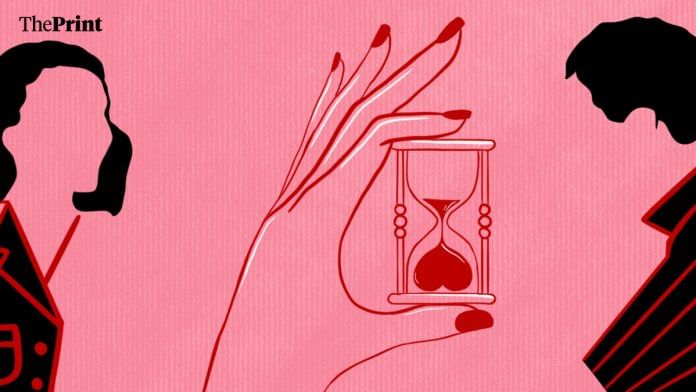Somewhere between the Dal Chawal minimalism of arranged marriage and the self-destructive maximalism of dating apps lies the modern Indian relationship. An ungainly creature, equal parts ambition, inertia, and risk management.
It is one of the more touching delusions of our Gen Z cohort that relationships are supposed to be fulfilling. Not merely adequate. Not efficient. Fulfilling. We want one partner who acts as a friend, lover, financial advisor, fitness coach, sous chef, unlicensed therapist, and, when required, a shoulder to cry on during layoffs.
This expectation isn’t entirely ahistorical. Our grandparents’ marriages weren’t always the stoic, transactional arrangements we imagine. Many found deep companionship, even tenderness, within their constraints. The difference is that they expected to work within those constraints rather than transcend them. They expected dinner. Obedient children. Companionship was a bonus, not a baseline. We, conversely, expect the stars to realign on command.
Despite all the TED Talks about communication and the Instagram therapists whispering about boundaries, most relationships—whether married, entangled, or confused—don’t operate on fairy tales. They operate on something more predictable: The mathematics of mutual reluctance.
For those lucky enough to have dodged a commerce degree, the Nash Equilibrium describes a state where no player benefits from changing their strategy unless the other players do too. In the context of love, it’s the realisation that the first person to demand more loses leverage. In simpler terms: “I won’t change if you won’t.”
Applied to modern Indian relationships, it’s devastatingly accurate. Picture the couple in SoBo. Or Gurugram. Or Koramangala. She resents that he never plans date nights. He resents that she notices. Both know the relationship is plateauing into quiet mediocrity. Neither says it aloud. Why? Because the risk of unilateral honesty of broaching the “what are we even doing” conversation carries a tax neither is willing to pay. It could trigger an argument. A breakup. Or worse: An awkward conversation involving parents, biodatas, and distant uncles offering astrologically guided life advice.
So both hold their positions. Neither happy. Neither miserable enough to leave. Equilibrium achieved.
This isn’t the cynical view of love; it’s the pragmatic one. Nash Equilibrium doesn’t describe the best possible outcome. It describes the most stable one. A suboptimal stalemate where everyone stays put.
Also read: Modern lovers are trapped in ‘chalta hai’ relationships. Breakups are a lost art
Breaking the equilibrium
Indians have refined this dynamic into something approaching performance art. Entire ecosystems of relationships subsist on tacit rules, polite evasions, and the quiet negotiation of unspoken boundaries. The situationship that lingers because “yeh baat karne ka mood nahi hai”. The marriage where both partners quietly outsource intimacy to Netflix, domestic help, and separate friend groups. The long-distance relationship that functions solely on the promise of a hypothetical 2026 wedding, contingent on someone clearing a CAT attempt, securing an on-site opportunity, or landing a Canadian PR.
To break the equilibrium is to risk everything. To say, “I want more,” or “This isn’t working,” is to step off the stability of the known and into the chaos of the unknown. Perhaps this is why South Delhi therapists have waitlists longer than the brunch reservation list at Olive, Mehrauli. Or why Bengaluru’s cafes are filled with people explaining their partners’ attachment styles over overpriced cortados. Everyone’s stuck. Everyone knows they’re stuck. No one wants to be the one to pull the pin.
Of course, real relationships aren’t board games. People aren’t purely rational actors making calculated moves. Emotions shift, circumstances change, and what feels stable today might feel suffocating tomorrow. Nash Equilibrium explains the stagnation. It does not explain the escape.
Sometimes the equilibrium breaks naturally. Someone gets a job offer in another city. A friend gets married and suddenly makes everyone else’s situationship look absurd. A parent falls ill and clarifies what actually matters. External shocks can dislodge even the most entrenched patterns.
And sometimes, and this is where Bollywood gets it right, grand gestures do work. Not the airport chases or rain-drenched confessions, but the quieter ones. The decision to stop calculating and start betting. The willingness to be vulnerable first, without guarantees.
The tragedy, or perhaps the mercy, is that most relationships persist not because they’re euphoric but because they’re stable. Predictable. Two people locked in the comfortable mathematics of mutually assured inertia. I won’t call out your weaponised procrastination if you don’t call out my emotional unavailability. You won’t question my inability to plan anything if I don’t question your refusal to discuss the future. Neither wins. Neither loses. But both survive.
This isn’t necessarily a failure. Stability has its own value, especially in a world that offers little of it elsewhere. The question isn’t whether this dynamic exists. It clearly does. But whether we can recognise it early enough to choose differently.
The real insight isn’t that relationships follow game theory. It’s that awareness of the game that creates the possibility of changing it. This requires what economists call “commitment devices” and what the rest of us call courage. The willingness to risk the stability of an “okay” relationship for the possibility of something better. Or the wisdom to recognise when stability itself is the better outcome.
People fall in love despite mismatched incentives, asymmetric emotional labour, and the ever-present threat that any serious conversation could end everything. Some people, knowing all this, still choose to break the equilibrium. To say what they mean. To risk wanting more.
Because in the end, the most stable relationship isn’t necessarily the best one. And the most terrifying thing isn’t being stuck in a suboptimal game; it’s never learning that you have the power to change the rules.
Janak Pandya is a brand strategist writing at the intersection of culture, cities, and human behaviour. He tweets @janakp14. Views are personal.
(Edited by Theres Sudeep)






